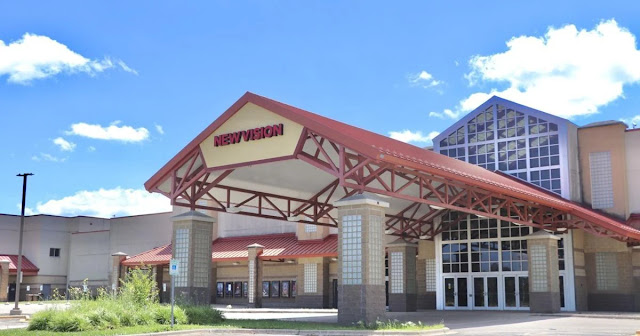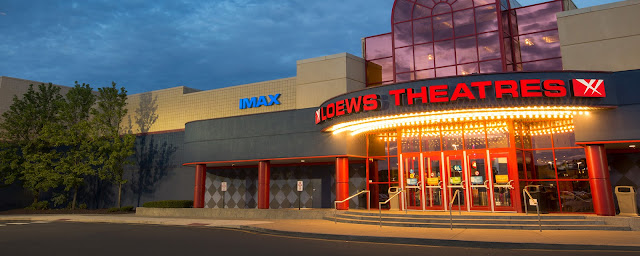The first known movie theatre that opened to the public dates to the early 1900s being referred to as the Nickelodeon. While this is not affiliated with the child network that brought us classic shows like Hey Arnold and SpongeBob, Nickelodeon was chosen as the word "Odeon” means “Theatre” in Greek and “Nickel” as the cost of administration to see the moving pictures.
Theatres today are currently finding innovative ways of staying afloat as many of them are competing against online movie streaming and consumers not wanting to pay the high-ticket pricing and concessions.
Today we will be going over a list of 10 Defunct Movie Theatre Chains that are no longer around.
10. New Vision Theatres
New Vision Theatres was formed in 2017 by the acquisition of Carmike Cinemas from AMC Theatres.
AMC agreed to divest 15 theaters to win Department of Justice approval for the merger, which made it the largest chain in North America.
Beekman Investment Partners (owners of New Visions) acquired the locations from AMC across 9 states with 184 screens and more than 500 employees.
After three years in operation and despite no known financial struggles before the COVID-19 crisis, the 18-location and roughly 200-screen movie theater operator was shut down permanently.
On August 28th, 2020, a court allowed AMC to reacquire 10 theatres it had previously divested leaving those unclaimed to remain shuttered.
9. Great Escape Theatres
Great Escape Theatres was a movie-theatre chain that operated movie theatres primarily in the Midwestern United States.
The first theatre opened in Bedford, Indiana in 1997 and soon opened locations in Indiana, Kentucky, Illinois, Ohio, Tennessee, Pennsylvania, West Virginia, Nebraska, Missouri, and Georgia.
Great Escape Theatres focused primarily on mid-size market areas consisting of populations between 100,000 and 400,000 people.
The company operated 305 screens at 26 locations before being sold to Regal Cinemas in December 2012 for approximately $91 million.
8. Consolidated Theatres (North Carolina)
Consolidated Theatres was a movie Theatre chain based in Charlotte, North Carolina operating 28 theatres and 400 movie screens in 6 states along the East Coast.
It was founded by Herman Stone in 1993, being a part of The Stone Group.
Consolidated Theaters was acquired by Regal Entertainment Group on May 1, 2008. As a condition of approval of the acquisition, the United States Department of Justice required that Regal sell 4 theaters in the Charlotte and Raleigh, North Carolina markets to Cinemark Theaters to ensure continued competition.
7. Magic Johnson Theatres
Magic Johnson Theatres was a chain of Movie Theatres originally developed in 1994 by Johnson Development Corporation, the business holding of basketball player-turned-entrepreneur Magic Johnson, and Sony Pictures Entertainment through a partnership with Sony-Loews Theatres.
The focus of Magic Theatres was to build first-rate multiplexes in urban communities, bringing high-quality facilities and technology, as well as job development, and encouraging local economic growth.
This was followed by Theatres opening at Greenbriar Mall in Atlanta, Georgia, and Randall Park in Cleveland Ohio.
During the partnership, 2 additional theatres were opened: Magic Johnson Harlem 9 in Harlem, New York City, and Magic Johnson 12 Capital Center in Largo, MD, a suburb of Washington, D.C.
In 2006, AMC acquired Sony-Lowes and rebranded many of the theatres as “AMC Magic Johnson.”
While the Cleveland Ohio and Atlanta, Georgia locations were closed by AMC due to lack of profitability, the Magic Johnson Crenshaw 15 was closed, renovated, and reopened as the Rave Cinemas Baldwin Hills 15 by the Rave Cinemas chain in 2011. It has since been renamed the Baldwin Hills Crenshaw Plaza 15
Earvin "Magic" Johnson, Jr., is no longer actively involved in the management committee, strategic planning, operations, or public relations.
6. Dickinson Theatres
The company was founded by Glen W. Dickinson, Sr. in 1920. The first small two-screen theatre opened in the booming agriculture college town of Manhattan, Kansas as The Dickinson Marshall Theatre.
After the success of the first theatre, a second location was opened less than 2 hours away in Lawrence, Kansas called the “The Dickinson Bowersock Theatre.”
By the 1930s Dickinson Theatres had grown to parent 26 theatres and continued to expand. It was at that time Dickinson decided to relocate the company office to Lawrence, Kansas.
Fast forward to the 90s, which marked the company's 75th anniversary and a year of great success. The company introduced the "Crown Jewel" to the Kansas City area, opening the extraordinary WestGlen 12 Theatre in Shawnee, Kansas. This theatre would later expand to 18 screens.
At this time, it was operating a total of 168 screens in 39 locations throughout Mid-America.
After several changes of leadership, Dickinson theatres were purchased by the Liberty, MO-based chain B&B Theatres in 2014 being rebranded under the same name.
5. General Cinema
The General Cinema Corporation also known as General Cinema or GCC (for short) was founded as a drive-in theatre in 1935 by Philip Smith.
The company did not see much growth until 1939, when World War II started, due to heavy sales of news printed on film.
After the war ended, the company assumed new leadership under Richard A. Smith, who had decided on pushing the company towards indoor movie theaters for all future expansions and had opened the country's first shopping center theatre, in Framingham Mall.
Starting in the 1960s General Cinema diversified into other businesses most notably forming a joint venture theater chain with Hoyts, known as Hoyts General Cinema, that had locations throughout South America.
The company also teamed up with Lew Grade's Associated Television Corporation to form Associated General Films, which produced films including Voyage of the Damned and Capricorn One, but the partnership ended the following year and ATV's ITC Entertainment subsidiary started financing films on its own.
In April 1992, the company collaborated with Lucasfilm to create mascots for the company. Within less than a year, the then-iconic Candy Band was created. Soon after, two more mascots were developed and named Popcorn Bob, and Pepsi Sue. All three developments were used in preshow reels from 1993 to 2002.
In 1993, General Cinema's holding company then named Harcourt General, spun off General Cinema as a separate company. The company suffered greatly when it filed for Chapter 11 bankruptcy in October 2000 and Chapter 7 bankruptcy in October 2001.
On December 7, 2001, AMC Theatres agreed to buy GC Companies, Inc. as part of GC's Chapter 11 reorganization plan with the acquisition being completed on March 29, 2002.
4. Muvico Theatres
Muvico Theaters started in 1984 with the acquisition of the Movie Center 3 theater in Coral Springs, Florida. Between 1985 and 1995, Muvico bought and built eight theaters totaling 59 screens.
Muvico's theaters were known for the use of decorative themes at several theaters, such as the Egyptian, 1950s drive-in, French opera house, Mediterranean palace, and 1920s grand movie palace themes.
Some locations were equipped with D-Box motion seat technologies, allowing the guest's seat to move to the action within the feature.
On November 4, 2013, Carmike Cinemas agreed to purchase Muvico Theaters for just under $31.8 million and the deal closed at the end of 2013.
3. Clearview Cinemas
Clearview Cinemas was formed in 1994 through a group led by Bud Mayo and was listed as a public company on the American Stock Exchange on August 19, 1997.
It became a subsidiary of the American cable television company Cablevision in 1998.
Clearview Cinemas offered a loyalty program called Clear Advantage which offered members “Free Movie Tuesdays” and other discounts.
In 2013 it operated a total of 47 movie theatres with 253 screens in the New York metropolitan area, including the famous Ziegfeld Theatre in New York City.
Ridgefield, Connecticut-based Bow Tie Cinemas purchased Forty-one of the Clearview Cinema locations from Cable Vision Systems on April 29th, 2013, making Bow Tie the largest exhibitor in the metropolitan New York area and the eighth-largest chain in the nation.
Bow Tie would manage the Ziegfeld Theatre in New York, although Cablevision retained ownership up until 2016 when the company itself was acquired by Altice.
2. Loews
Loew's Theatres Incorporated was formed in 1904 in Cincinnati, Ohio, by entrepreneur Marcus Loew.
To provide quality films for his theaters, Loew founded Metro-Goldwyn-Mayer (MGM) in 1924, by merging the earlier firms Metro Pictures, Goldwyn Pictures, and Louis B. Mayer Productions.
Loews Corporation, the successor company to the original firm founded by Marcus Loew, announced on April 9, 1985, that it was negotiating to sell Loews Theatres to a group headed by A. Jerrold Perenchio.
On October 20, 1986, when federal regulations had been relaxed, Tri-Star Pictures, then a joint venture co-owned by The Coca-Cola Company (also owners of Columbia Pictures at the time) and Time Inc.'s HBO, entered an agreement to acquire Loews Theatre Management Corporation for $300 million which closed December.
In September 1997, Cineplex Odeon Corporation announced that it would merge with Loews Theatres for $1 billion, the merger was later approved by the United States Department of Justice on April 16, 1998, and was later completed that year to form Loews Cineplex Entertainment, thus making it a joint venture between Sony and Universal Studios.
The combined company was one of the largest movie exhibitors in the world with theatres in the United States, Canada, Mexico, South Korea, and Spain.
The company was forced to sell its newly acquired subsidiary, Cineplex Odeon Films, to Alliance Atlantis, which was formed from the merger of Alliance Entertainment Corporation and Atlantis Communications that year. In 2001, though, the company declared Chapter 11 bankruptcy. Among the changes were the closures of 46 theatres in North America including 21 Loews theatres in the U.S. and 25 Cineplex Odeon theatres in Canada.
AMC Theatres announced in 2005 that it would merge with Loews Cineplex Entertainment and that the merged company would adopt the AMC name. At the time of the merger, Loews operated 198 theaters with 2,235 screens. Many theaters were rebranded as AMC Loews until the Loews name was phased out in 2017.
1. Carmike Cinemas
Carmike was founded when Carl L. Patrick, Sr. acquired Martin Theatres from Fuqua Industries in 1982.
The company's name was derived from a combination of the first names of Carl L. Patrick, Sr.'s two sons, Carl Jr. and Michael, hence "Carmike".
In 1997, Carmike partnered with Walmart to start the Hollywood Connection, starting with a location in Columbus, Georgia. Amenities include a modern multiplex or megaplex movie theater with 5–15 screens, indoor miniature golf, a roller-skating rink, a laser tag arena, and a video game arcade
Carmike filed for Chapter 11 bankruptcy protection in August 2000 after failing to make US$9 million in interest payments to bondholders. The company exited bankruptcy in 2002 after selling many of its smaller and historic theatres.
Carmike would acquire more theatres purchasing 30 GKC Theatres from Beth Kerasotes in 2005, 3 theatres from MNM Theatres in 2011, and 16 theatres from Rave Cinemas in 2012 (purchasing an additional 3 more a year later).
In 2016 the company had about 276 theatres making it the fourth-largest theatre in the United States.
Thar same year, AMC Theatres announced its intent to acquire Carmike Cinemas in a $1.1 billion deal, subject to regulatory and shareholder approval. The deal was completed on December 21, 2016, in which AMC overtook Regal Entertainment Group as the United States' largest movie theater chain.
In February 2017, AMC announced it would discontinue the Carmike name and re-brand all its locations under the AMC, AMC Classic, or AMC Dine-in banner.
Most of Carmike's former locations were converted to the AMC Classic banner, which denotes smaller locations with fewer premium amenities than the AMC and AMC Dine-In banners.
The AMC Classic banner uses Carmike's trademarks, including the folded film logo and the "America's Hometown Theatres" slogan.














.png)
No comments:
Post a Comment